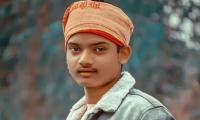The writer is a Kashmiri activist and former journalist.
Mrs Parveena Ahangar has been sitting in the corner of Srinagar's Partap Park in protest every month since August 1990. She has been waiting to know about her sixteen-year-old missing son, Javed, who according to neighbours was arrested by Indian security forces. Javed has never been seen or found in any prison of India where thousands of Kashmiri boys as young as fifteen or sixteen have turned adults under the high voltage lamps of interrogation cells.
This is the story of those ten thousand destitute and feeble women whose husbands have never returned home after they were taken into custody during the political turmoil in Jammu and Kashmir. Since their disappearance, they live under the pretence that they are still married to them and cannot compromise with the honour of the family even if they have to sleep on an empty stomach or face hundreds of uniformed men searching their houses in the middle of the night. They are left with broken homes, broken souls, and broken dreams.
Kunan Pushpura's young girl, Bano (name changed) wakes up every night with nightmares of that night in the early '90s when she failed an attempt to jump out of a window after witnessing her mother and 40 other women groped and gang-raped by hundreds of soldiers who had come to cordon off the twin villages of Kupwara. She has become used to keeping her eyes open during the night.
I will take you to the balcony of Shopian's Neelofer Jan and Aasiya Jan where ripped and blood-soaked trousers are still hanging on the wall that has been kept as a reminder of that dreadful night when they were abducted and raped. The government at that time announced that both these women had drowned in the nearby river. Contrary to the official claim, their bodies were found rotting in the heap of the rain-soaked crop they had gone to harvest for the advancing winter. Many in this locality believe the house has become haunted since then by their ghosts.
The character in 'beyond silence' is not the eight-year-old nomad girl of Rasana Jammu who you might have seen on the front pages of the international press. Yes, the same girl who was abducted, drugged, raped and stoned to death by her Hindu neighbours who later on along with Hindutva gangs took to the streets in support of the rapists and scared the Gujjar community to leave the area in the darkness. The mutilated body found in the temple didn't get permission for burial and her parents had to run for life carrying the weight of her dead body while passing through the wild jungle of Rasana.
I will give you the eyewitness account of those young girls who, living on the Line of Control, have to endure bodily harm every day under the guise of getting frisked while passing through the military bunkers to reach school.
My story can hardly find an expression for the stigma faced by the hundreds of frail women of Dardpora village which is called the village of 'half widows' who live on handouts or wait for local charities to feed them. The village has no men except military bunkers or vehicles. All the men have either fled the village or have been killed during cordon and search operations.
I can show you the faces of those disfigured 500 widows of Shonglipura whose protectors were killed. And then there are the 40,000 women of Kashmir who did not get married since most of the boys they were engaged to got killed in armed encounters with the Indian army. There are many unidentified graves in every district of Kashmir with number plates. Nobody knows who has been dumped there and how many are in one grave.
There is also the story of millions of married women waiting on the threshold of their houses during search and cordon operations when they keep looking at their husbands who have been taken away in a line by army soldiers. Our women have developed a habit of sitting together near the main door if alone at home so that they will not have to face the wrath of a barging soldier on their own.
Do not ever compel me to take you to hear the screams of thousands of women whose fathers, brothers, sons, and husbands have been languishing in Indian jails for decades and seem forgotten now. Many children born before their arrests have no clue of who their father is or where he is. Some live like orphans and some are going from pillar to post to find them.
I will not let you walk away from the agonizing sobs of those 13,000 mothers whose innocent children as young as twelve years old were dragged out of their beds in the middle of the night of August 4, 2019 and placed in unknown prisons thousands of miles away from Kashmir.
There are four million characters in my book who you might find funny, for being considered a symbol of courage, strength, martyrdom and bravery but there is no vocabulary in the dictionary to describe their transmutation into stones and rocks. There has been no way to find the timeline of how long it took them to get their tears dried up.
This whole page of my book cannot tell you the desolation of the thousands of women who have become accustomed to showing their ID cards every ten to twenty meters to security guards all over the valley and how they have learned the art of covering their faces and bodies in black chador to avoid the leering eyes of the soldiers.
In this story, there is no space left for Rani, the policewoman, who would derive pleasure in searching women's bodies in the notorious interrogation center of Srinagar, then expose them to her counterparts who would ridicule and taunt these stripped and lifeless bodies of Kashmiri women. I will find a proper place for Arundhati Roy who has met these stripped women and raised their plight everywhere she goes. She has become the voice of the silent women of Kashmir and gives them hope to stay alive.
The theme of my book might not include the rising suicide cases of army soldiers in Kashmir after they watch the mutilation of the dead bodies of Kashmiri boys killed by their colleagues in fake encounters, but I will include the story of a special task force that set fire to the hut and paddy stock of an eighty-year-old woman of South Kashmir and forced her to beg for shelter and food.
My story has deliberately ignored the dream of the mother of Burhan Wani. She wanted him to get higher education but he vowed to fight against the atrocities he witnessed during the Indian army's search operations. But I cannot afford to ignore ten thousand young boys and girls who have been deprived of their eyesight by the indiscriminate firing of pellets and bullets after Burhan was killed by Indian forces.
I cannot find the strength to speak about four-year-old Hibba who had undergone several eye surgeries after she got pellets in her eye but I do confess my guilt of feeling elated at the news of Insha, a brave girl of Shopian, who passed her board examination despite losing both eyes to pellets.
Sixty-five percent of the women in my story are declared psychologically ill as a result of the constant violence, daily funerals, and loss of livelihood in Kashmir. Psychiatrists and counsellors have become severely ill by the magnitude of the ailing mental health in the valley.
Kashmir is considered ‘paradise on earth’ but the political turmoil, border clashes, betrayals, continual bloodshed, and now the vendetta policy of the Hindutva brigade have made the Kashmiri woman so weak that she might rename this paradise a beautiful hell on earth where she stands surrounded by guns and gunmen.
I often ask myself: shall I make her die a slow death in my book or keep crying my heart out to wake up the silent world to listen to her sobs and save her from further degradation and dehumanization? What would you do?
A woman walks past a building of the International Monetary Fund. — AFP/FileThe annual and spring meetings of the...
Late Benazir Bhutto's daughter Asifa Bhutto Zardari addresses the Christian community in Bihar Colony on January 23,...
Representational image. — PexelsWater is an important scarce natural resource that is required for several everyday...
Pakistani employees of online marketplace company Kaymu at work in Karachi. — AFP/FileThe true spirit of development...
India uses Afghanistan as a backstage area to carry out terrorist attacks against Pakistan
Another report by the Pakistan Institute of Peace Studies states that 78 per cent of attacks have been carried out by...







